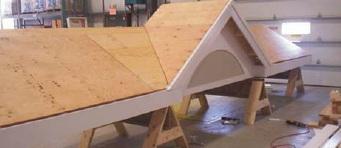
Guest Blogger: Melanie Hodgdon is a Certified QuickBooks ProAdvisor who has been providing financial analysis and QuickBooks training for contractors since 1994. She’s the co-author of A Simple Guide to Turning a Profit as a Contractor. Melanie and Shawn often coordinate their efforts when helping remodelers develop financial systems for their businesses so they serve the contractor, not just their accountant.
Understanding and Including General Production Costs in Your Estimates
Estimators are pretty good about including costs for permits, materials, subs, and equipment rental in their estimates. And the really topnotch ones are also adept at estimating the amount of labor time based on knowledge of what their crew(s) can produce. But there is another element that often eludes even the most careful of estimators: the cost of those “necessaries” that will be used on a job but not easily assigned to specific jobs.
These include things like:
 Bits
Bits- Blades
- Rags and other cleaning supplies
- Sanding disks and sand paper
- Trash bags
- Small tools
- Dust masks
- Assorted fasteners
- Caulking and adhesives
- Pencils, markers and chalk
Here are some more candidates:
 Cost to repair and maintain tools and equipment
Cost to repair and maintain tools and equipment- Cost to maintain a jobsite trailer
- Propane for the space heater
- HEPA filters
- Bungies, ropes and tie downs
- Trash barrels or bins
These can be considered General Production Costs and you should have a method to allow for them in the job price.
Two ways to price your work
Basically, pricing consists of identifying the actual cost of X and then adding a markup. The purpose of the markup is to allow the selling price to cover not just what X costs, but also it’s fair share of the company overhead, with enough left over to contribute to company profit.
Option A: Include in the estimate

When you include an allowance for General Production Costs in your estimate, you increase the predicted cost of the job. When you apply a markup to the cost, you will also be marking up the predicted General Production Costs. Because you are charging your customer for the cost (income account), the matching cost should be considered Cost of Goods Sold.
For many contractors, including an allowance for these costs in the estimate will increase the likelihood that the costs will be covered.
Option B: Include in the markup

If you consider General Production Costs as being part of the cost of doing business (overhead), then you will account for them by increasing your markup on the job.
Ideally, both methods will result in the same selling price. However, in my experience, far too many contractors decide on a markup based not on the financial requirements of their company, but rather on a figure they found in an article, or what scuttlebutt tells them their competition is using. This WAG (wild ass guess) approach decreases the likelihood of capturing these costs in the markup.
Why I typically recommend Option A
Also, as companies have diversified with changes in the economy, the type of work they do has also changed in many cases. Burying these costs in overhead can make the changes less obvious than placing them in Cost of Goods Sold where significant changes are more likely to be spotted. For example, companies performing lots of RRP work might see a significant increase in these costs due to the requirement for filters, respirators, contractor bags, signage, duct tape, Tyvek suits, etc. The effect on the gross margin (when these costs reside in Cost of Goods Sold) might be noticed more quickly and reliably than remembering to deliberately dig into the overhead accounts to find and monitor them.
Estimating vs. job costing considerations

Once your General Production Costs are part of Cost of Goods Sold, an allowance for the inevitable cost can be included in the estimate. This means that you will charge for them as part of your pricing strategy. However, because of their very nature, you won’t be able to attribute them to individual jobs, so when you look at job cost reports, you will not see an “actual cost” for these items, making the jobs appear slightly more profitable than they probably are. The achieved margins of all the jobs will look higher than the overall achieved margin from the Profit and Loss Statement since the Profit and Loss Statement will contain the dollars spent on General Production Costs and the individual job reports won’t.
How to calculate General Production Costs for estimating purposes
The simplest way is by comparing General Production Costs with Materials costs. Express the relationship as a ratio or percentage. For example, if in the last twelve months you spent $500,000 on materials and $8,000 on General Production Costs, you will need to add 1.6% ($8,000 ÷ $500,000) to your estimate to cover them. When estimating, this figure can be added as a line item as shown in the sample estimate template below.

Screen shot from Shawn's new estimating Template
Final thoughts
Each job has enough surprises in it. Why not at least plan your sell price to include an allowance for the costs you know you can count on?

Need help with General Production Costs?
Call or Email Shawn today.
Do it now so you can be confident you are pricing your spring and summer projects correctly!
 OK, I’m sick and tired of the foo-foo fluffy BS answers some magazines and bloggers put out there to answer how contractors can raise their markup. All the BS answers I see offered by others never call these contractors out on their ignorance. Without knowing what markup they actually need to use how would a contractor who is “slowly raising” his markup know when he has finally hit the right markup? It drives me crazy! If you are ready for the no BS answers read on…
OK, I’m sick and tired of the foo-foo fluffy BS answers some magazines and bloggers put out there to answer how contractors can raise their markup. All the BS answers I see offered by others never call these contractors out on their ignorance. Without knowing what markup they actually need to use how would a contractor who is “slowly raising” his markup know when he has finally hit the right markup? It drives me crazy! If you are ready for the no BS answers read on…


 Builders, remodelers and lumber dealers often get in trouble with lumber framing packages by overlooking the obvious…the volatile lumber market. Most contractors and lumber dealers do not have the luxury of pricing a job today, signing it tomorrow and buying the required materials the next day. By the time a job is priced, signed and the lumber gets delivered to the jobsite 30, 60 or even 90 or more days may have passed and lumber prices may have changed as much as 20%. At the Estimating Workshops I did this concern comes up quite often and attendees often share how their profits are affected as a result.
Builders, remodelers and lumber dealers often get in trouble with lumber framing packages by overlooking the obvious…the volatile lumber market. Most contractors and lumber dealers do not have the luxury of pricing a job today, signing it tomorrow and buying the required materials the next day. By the time a job is priced, signed and the lumber gets delivered to the jobsite 30, 60 or even 90 or more days may have passed and lumber prices may have changed as much as 20%. At the Estimating Workshops I did this concern comes up quite often and attendees often share how their profits are affected as a result. He says some weeks do not change at all. However he also points out that 70% of the time they do change by an average 2.5% each week or 10% per month. Based on those realities a contractor who estimates a framing package using today’s lumber costs at $10,000 may end actually paying over $13,000 for that same package 90 days later. For those of you who understand how margins and markups work, not only will the contractor have lost the $3300 due to price increases, but also the gross profit margin on that difference. At a 50% markup that’s another $1650 of gross profit that could have been included in the sell price to help cover overhead and profit.
He says some weeks do not change at all. However he also points out that 70% of the time they do change by an average 2.5% each week or 10% per month. Based on those realities a contractor who estimates a framing package using today’s lumber costs at $10,000 may end actually paying over $13,000 for that same package 90 days later. For those of you who understand how margins and markups work, not only will the contractor have lost the $3300 due to price increases, but also the gross profit margin on that difference. At a 50% markup that’s another $1650 of gross profit that could have been included in the sell price to help cover overhead and profit.
 I came across a great question asked by a group member while participating on LinkedIn. I replied to the question on LinkedIn, but also thought it would make for great info to share with other contractors who might be asking the same question.
I came across a great question asked by a group member while participating on LinkedIn. I replied to the question on LinkedIn, but also thought it would make for great info to share with other contractors who might be asking the same question. Also consider, as a business owner you may personally be measuring your profitability including the costs of any investments for a one year period. As a result may not see a profit in the bank at the end of the year. However the money spent on those investments is still considered profit for business and tax purposes. This is the case because when filing your taxes the government sees these investment type purchases as assets paid for with profits. To get tax deductions for these assets you are allowed to depreciate the assets over time to reduce their value and take tax deductions for them over several years or more. Essentially, for tax purposes, the government measures your profit by combining the money you earned and still have; along with the assets you bought using any profits, as your total taxable net profit. Also, any money your business paid out to you the owner as profit distributions over the year will be considered part of your business’ total taxable net income.
Also consider, as a business owner you may personally be measuring your profitability including the costs of any investments for a one year period. As a result may not see a profit in the bank at the end of the year. However the money spent on those investments is still considered profit for business and tax purposes. This is the case because when filing your taxes the government sees these investment type purchases as assets paid for with profits. To get tax deductions for these assets you are allowed to depreciate the assets over time to reduce their value and take tax deductions for them over several years or more. Essentially, for tax purposes, the government measures your profit by combining the money you earned and still have; along with the assets you bought using any profits, as your total taxable net profit. Also, any money your business paid out to you the owner as profit distributions over the year will be considered part of your business’ total taxable net income. Again, great question to ask. I hope this article helps. Being a business owner means you have to understand how to manage and protect the profits you earn, but at the same time manage how you will be taxed on that same money. By not knowing or ignoring these considerations you can be working hard to make money while profits that could have stayed with you are going out the door to the government as taxes. That said there are a lot of great reasons to have a proactive accountant helping you and your business instead of a historian type accountant who only files your taxes for you when everything is already said and done for the year.
Again, great question to ask. I hope this article helps. Being a business owner means you have to understand how to manage and protect the profits you earn, but at the same time manage how you will be taxed on that same money. By not knowing or ignoring these considerations you can be working hard to make money while profits that could have stayed with you are going out the door to the government as taxes. That said there are a lot of great reasons to have a proactive accountant helping you and your business instead of a historian type accountant who only files your taxes for you when everything is already said and done for the year.
 Bits
Bits Cost to repair and maintain tools and equipment
Cost to repair and maintain tools and equipment





 The contractor includes the time/cost to do the estimate inside the estimate as a line item.
The contractor includes the time/cost to do the estimate inside the estimate as a line item.

 Try to get your clients to make their selections during the design phase.
Try to get your clients to make their selections during the design phase.

 With the right manager and company, a good lead carpenter has a huge opportunity for personal and professional growth. Proper training as well as the ability to implement what is learned creates many opportunities for a lead carpenter. As we implemented the system at my remodeling company, our leads discovered that this new role generated a variety of benefits for them. For example; our leads discovered that they could delegate to others those activities that they preferred not to do.
With the right manager and company, a good lead carpenter has a huge opportunity for personal and professional growth. Proper training as well as the ability to implement what is learned creates many opportunities for a lead carpenter. As we implemented the system at my remodeling company, our leads discovered that this new role generated a variety of benefits for them. For example; our leads discovered that they could delegate to others those activities that they preferred not to do.
 Fewer risks of losing and replacing in-house production employees
Fewer risks of losing and replacing in-house production employees
 Projects are most profitable and clients are happiest when everything happens as originally planned. Any changes to that plan can cause frustration for either party and may reduce your ability to get referrals if the client sees the changes as your fault. Before allowances throw a monkey wrench into your schedule, help prospects discover what will happen if selections are not made on time, or they choose products that will not be available when needed to keep the project moving as planned. Make sure you do this and mutually agree on things before you allow them to become clients!
Projects are most profitable and clients are happiest when everything happens as originally planned. Any changes to that plan can cause frustration for either party and may reduce your ability to get referrals if the client sees the changes as your fault. Before allowances throw a monkey wrench into your schedule, help prospects discover what will happen if selections are not made on time, or they choose products that will not be available when needed to keep the project moving as planned. Make sure you do this and mutually agree on things before you allow them to become clients!


 Building product suppliers who have high debt may not be able to finance the cost of increasing their inventories to keep up with the predicted supply and demand challenges as the economy improves. If this happens at your supplier you may find that many products, even common commodities like framing lumber, will be out of stock. Imagine going to the lumberyard first thing in the morning to get the materials you need to frame a deck or reframe that kitchen, only to find out you can’t get what you need. To keep working that day you might have to pay for longer lengths than you need, or might even have to drive to a different supplier in the hopes that they will have what you need so you can work that day. Remember, if you lose two hours chasing materials, in reality you also lost two hours of productive time on the job. That would mean you lost a total of four hours you could have billed your client for if the materials were already at the jobsite.
Building product suppliers who have high debt may not be able to finance the cost of increasing their inventories to keep up with the predicted supply and demand challenges as the economy improves. If this happens at your supplier you may find that many products, even common commodities like framing lumber, will be out of stock. Imagine going to the lumberyard first thing in the morning to get the materials you need to frame a deck or reframe that kitchen, only to find out you can’t get what you need. To keep working that day you might have to pay for longer lengths than you need, or might even have to drive to a different supplier in the hopes that they will have what you need so you can work that day. Remember, if you lose two hours chasing materials, in reality you also lost two hours of productive time on the job. That would mean you lost a total of four hours you could have billed your client for if the materials were already at the jobsite. Lumber and building materials dealers who cut back on staff may also be challenged to help you sell to your customers. If you had a customer who wanted to see the door, cabinets or windows you recommend, will you be able to send them down to your local supplier to see the products they are looking for? What is the condition of the showroom? Is there going to be anyone there to make and take the time to meet with and help your customer? Will the person working at that dealer have the sales skills, product knowledge and knowledge about you and your business to help you make the sale?
Lumber and building materials dealers who cut back on staff may also be challenged to help you sell to your customers. If you had a customer who wanted to see the door, cabinets or windows you recommend, will you be able to send them down to your local supplier to see the products they are looking for? What is the condition of the showroom? Is there going to be anyone there to make and take the time to meet with and help your customer? Will the person working at that dealer have the sales skills, product knowledge and knowledge about you and your business to help you make the sale?

 At a recent Remodeler Summit event I participated in for
At a recent Remodeler Summit event I participated in for 

 At a tour of
At a tour of 
 Both examples above can help contractors earn more money in less time. Both examples offer ways contractors can get more work done without having to add any additional talents or skills to their crews. Both examples also eliminate or reduce the need to find and bring in sub contractors to do work the contractor’s own crews either don’t have the talents for or might not be cost effective at doing.
Both examples above can help contractors earn more money in less time. Both examples offer ways contractors can get more work done without having to add any additional talents or skills to their crews. Both examples also eliminate or reduce the need to find and bring in sub contractors to do work the contractor’s own crews either don’t have the talents for or might not be cost effective at doing.





